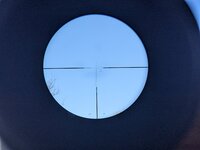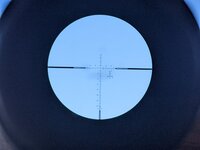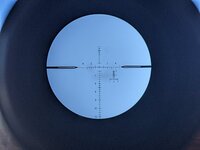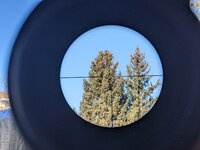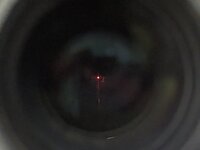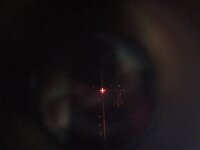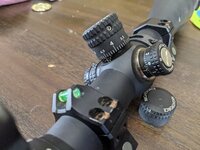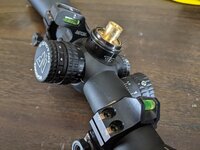sndmn11
"DADDY"
Nightforce 4-14x50 SHV F1 drop testing and mini evaluation. It was pointed out to me that I need to proof the rifle/mount/rings system. @HawkinsPrecision rings, Tikka T3 action with 22BR barrel from Preferred, in a Bell and Carlson stock. This scope is my own, one of two, and I have had it for three years or so.
Sight in shots (left black circle) were high and right. Corrections of .3mil left and .4mil down were made, and the next two shots printed slightly left.
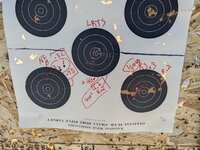
Protocol was as closely adhered to as possible https://www.rokslide.com/forums/threads/scope-field-eval-explanation-and-standards.246775/
~18" drops right/top/left with single shot in between, ~36" drop right/top/left single shot in between, ~36' drop rightx3/topx3/leftx3 single shot. 7 shots with 15 drops.

The above drop testing was done outdoors at 100 yards, 20-30deg, off and on wind, and other things needed to be fit into the day. The SHV was taken off the rifle and two other drop tests were performed. The following day I went to an indoor 100 yard range to do testing of adjustment value and return to zero in a very abbreviated manner. The same was done with one other scope, and then this SHV remounted in the rifle.
One shot was taken about ten minutes after the rifle was last fired as a "cold" zero. I then loosened the "zero set" turret, raised it up a few revolution marks, and tighted the set screws with the 0 mark aligned but not on the scope body so that I could dial down. I dialed down 5 mils (one revolution) fired one shot, up 10 mils (two revolutions) fired a shot, down 10 mils (two revolutions) fired a shot, up 10 mils shot, down 10 mils shot, and then down 5 mils to the 100 yard zero. This was a total of 3 shots down 5 mils from zero and 2 shots up 5 mils from 100 yard zero these were aimed at the green spot from the day prior because that gave me space on the board both ways. I then shot again at the same spot used for the "cold" zero check and it touched that shot. If one compares the majority of the shots on the drop test spot and the cold/hot zero, one can see they would probably overlap some and this is also after the scope was taken off the rifle, and the rifle dropped for testing with other scopes in between.
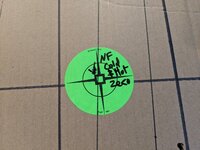
5 mils should be 18" (1' 6").
Dialing up came to ~1' 5 25/32" from the bullet holes at 100 yard zero.
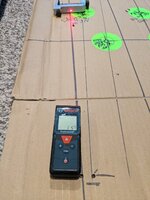
Dialing down came to ~1' 6 7/32"
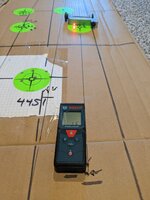
I DID NOT follow the 5 shots up, 5 shots down, and full 10 shot return to zero protocol for a few reasons. 1) I was running shot on time. 2) I have 30 cartridges loaded that were among the batch of 300 on virgin brass. In the event I need to retest the LRTSi or Maven RS.3, I do not know if something will change with once fired brass. 3) I own this scope and can share results later. 4) @Formidilosus probably has oodles of data as well, and nothing went wonky with this scope and the tests I went through. In other words, things were working and I accepted that.
Some will notice multiple "plum" lines on the cardboard, The indoor range is multiple lanes with cable/track target carriers to run the targets to the end. I did take a level and stapled the target up plum/level, but by the time it settled at the end, it was not plum. I have multiple levels on the scope, and used those to shoot. For the 5mil up and 5mil down shots, a straight line can be made from those two groups bisecting the green circle aiming point. I drew the line to show this. I think my logic is sound in that if the scope tracked in a curve, a straight line could not be made between the three points. This is also why I stopped because the best test would be on a plumed target like I can do at the outdoor range.
Sight in shots (left black circle) were high and right. Corrections of .3mil left and .4mil down were made, and the next two shots printed slightly left.

Protocol was as closely adhered to as possible https://www.rokslide.com/forums/threads/scope-field-eval-explanation-and-standards.246775/
~18" drops right/top/left with single shot in between, ~36" drop right/top/left single shot in between, ~36' drop rightx3/topx3/leftx3 single shot. 7 shots with 15 drops.

The above drop testing was done outdoors at 100 yards, 20-30deg, off and on wind, and other things needed to be fit into the day. The SHV was taken off the rifle and two other drop tests were performed. The following day I went to an indoor 100 yard range to do testing of adjustment value and return to zero in a very abbreviated manner. The same was done with one other scope, and then this SHV remounted in the rifle.
One shot was taken about ten minutes after the rifle was last fired as a "cold" zero. I then loosened the "zero set" turret, raised it up a few revolution marks, and tighted the set screws with the 0 mark aligned but not on the scope body so that I could dial down. I dialed down 5 mils (one revolution) fired one shot, up 10 mils (two revolutions) fired a shot, down 10 mils (two revolutions) fired a shot, up 10 mils shot, down 10 mils shot, and then down 5 mils to the 100 yard zero. This was a total of 3 shots down 5 mils from zero and 2 shots up 5 mils from 100 yard zero these were aimed at the green spot from the day prior because that gave me space on the board both ways. I then shot again at the same spot used for the "cold" zero check and it touched that shot. If one compares the majority of the shots on the drop test spot and the cold/hot zero, one can see they would probably overlap some and this is also after the scope was taken off the rifle, and the rifle dropped for testing with other scopes in between.

5 mils should be 18" (1' 6").
Dialing up came to ~1' 5 25/32" from the bullet holes at 100 yard zero.

Dialing down came to ~1' 6 7/32"

I DID NOT follow the 5 shots up, 5 shots down, and full 10 shot return to zero protocol for a few reasons. 1) I was running shot on time. 2) I have 30 cartridges loaded that were among the batch of 300 on virgin brass. In the event I need to retest the LRTSi or Maven RS.3, I do not know if something will change with once fired brass. 3) I own this scope and can share results later. 4) @Formidilosus probably has oodles of data as well, and nothing went wonky with this scope and the tests I went through. In other words, things were working and I accepted that.
Some will notice multiple "plum" lines on the cardboard, The indoor range is multiple lanes with cable/track target carriers to run the targets to the end. I did take a level and stapled the target up plum/level, but by the time it settled at the end, it was not plum. I have multiple levels on the scope, and used those to shoot. For the 5mil up and 5mil down shots, a straight line can be made from those two groups bisecting the green circle aiming point. I drew the line to show this. I think my logic is sound in that if the scope tracked in a curve, a straight line could not be made between the three points. This is also why I stopped because the best test would be on a plumed target like I can do at the outdoor range.
Last edited:


